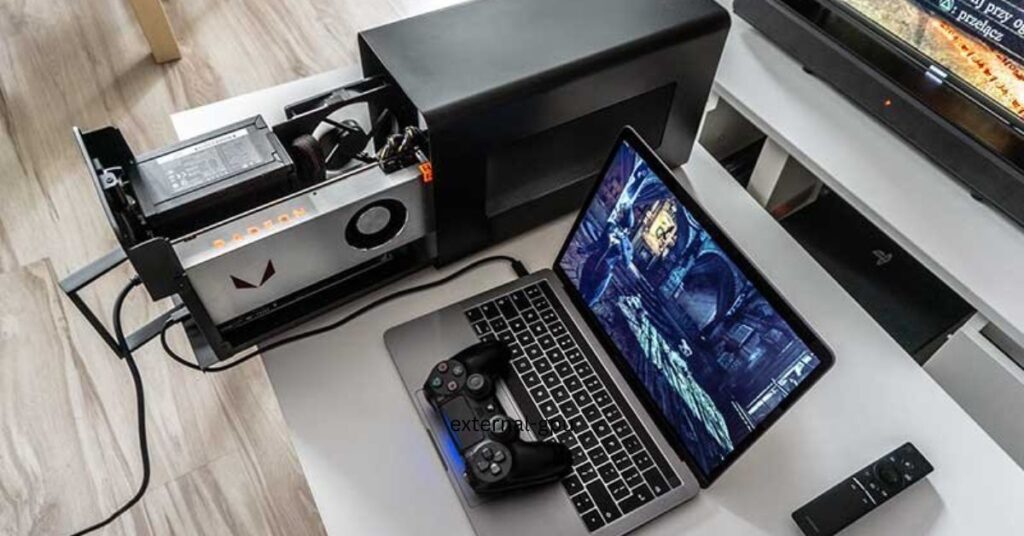An external GPU is a box you plug into your laptop to make games, videos, and design apps run faster—great for weak or old laptops.
This guide will help you decide if an eGPU is the upgrade you’ve been looking for.
Introduction
An External GPU (eGPU) is a smart solution for anyone who wants desktop-level graphics power on a laptop. By connecting a desktop graphics card through an external enclosure, your laptop can suddenly handle gaming, video editing, 3D work, and even AI tasks with ease. It’s the perfect upgrade for students, gamers, and professionals who want high performance without giving up the portability of their lightweight laptop.
How Does an eGPU Work?
The Role of Thunderbolt 3/4
Thunderbolt provides the high bandwidth needed for fast GPU communication with the CPU. While not as fast as a desktop PCIe slot, it’s sufficient for major performance gains.
GPU Enclosures Explained
The enclosure acts as a docking station. It includes a power supply, cooling, and a PCIe slot for your GPU.
Connection to External Monitors
For best results, plug your monitor directly into the eGPU’s HDMI/DisplayPort output. This reduces data transfer bottlenecks.
Components of an eGPU Setup
- GPU Enclosure (Dock): The shell that houses the GPU and powers it.
- Desktop Graphics Card: Choose between AMD or NVIDIA cards depending on needs.
- Power Supply & Cooling: Ensures stable performance.
- Expansion Ports: Some enclosures add USB ports, Ethernet, or storage support.
Pros of Using an eGPU
- Major performance boost for gaming and work.
- Portability: Easy to unplug and carry.
- Upgradeable: Swap GPUs as new models are released.
- Helps reduce e-waste by extending laptop use.
Cons of Using an eGPU

- Expensive: Enclosure + GPU can cost more than a desktop.
- Performance bottlenecks: Limited bandwidth means 10–20% lower performance than desktop use.
- Not all laptops support it.
- Bulky: Enclosures aren’t as portable as the laptop itself.
Popular External GPU Enclosures
- Razer Core X – Sleek, powerful, supports most GPUs.
- Sonnet eGFX Breakaway Box – Affordable and reliable.
- Akitio Node Titan – Compact with good cooling.
- ASUS ROG XG Station 2 – Gamer-focused with RGB design.
- Mantiz Saturn Pro – Offers expansion ports beyond GPU use.
How to Choose the Right eGPU
- Laptop Compatibility: Must support Thunderbolt 3/4 with eGPU certification.
- Power Requirements: Ensure enclosure PSU matches GPU needs.
- GPU Support: Some enclosures favor AMD, others support both brands.
- Budget: Balance enclosure and GPU price for best value.
Setting Up an eGPU Step by Step
- Choose an Enclosure & GPU that fits your workload.
- Connect via Thunderbolt to your laptop/PC.
- Install GPU Drivers (NVIDIA/AMD).
- Configure for Performance in system settings.
- Test with Benchmarks to verify performance gains.
eGPU for Gaming
eGPUs can transform a basic ultrabook into a gaming powerhouse. While not as efficient as a desktop, they handle 1080p and 1440p gaming well. 4K gaming is possible with high-end cards, though bandwidth limits can slightly reduce frame rates.
eGPU for Professional Work
For professionals, eGPUs shine:
- Video Editing: Faster previews and exports.
- 3D Modeling: Smoother workflow in Blender, Maya, or Cinema4D.
- AI Workloads: Training models faster with CUDA cores or AMD accelerators.
Cost of an eGPU Setup
- Enclosures: $250–$400 on average.
- GPUs: $300–$1500 depending on model.
- Total Setup: $600+ (similar to a gaming PC but with added portability).
Alternatives to eGPU
- Cloud Gaming Services: NVIDIA GeForce NOW, Xbox Cloud Gaming.
- Desktop Upgrade: More cost-effective if portability isn’t needed.
- Portable GPU Laptops: Gaming laptops with built-in RTX GPUs.
Future of External GPUs
The future looks bright as Thunderbolt 5 promises even higher bandwidth, reducing performance loss. AI-ready laptops may integrate modular GPU docking, making external GPUs more seamless and efficient.
FAQ’s
1. Is an eGPU worth it for gaming?
Yes, especially if you own a lightweight laptop. While slightly slower than desktops, it offers massive performance gains.
2. Can any laptop use an eGPU?
No. Your laptop must support Thunderbolt 3/4 with eGPU compatibility.
3. Does an eGPU reduce performance compared to desktops?
Yes, usually 10–20% slower due to bandwidth limits, but still a huge upgrade.
4. How long does an eGPU last?
Enclosures can last 5–10 years, while GPUs can be upgraded anytime.
5. What’s the cheapest eGPU setup?
Entry-level enclosures cost ~$250, and pairing with a mid-tier GPU ($200–$300) offers good value.
Conclusion
An external GPU is the perfect bridge between portability and performance. Whether you’re a gamer, content creator, or researcher, an eGPU transforms your laptop into a near-desktop powerhouse. While costly, it provides flexibility, upgradeability, and extended laptop life. For those needing serious power without giving up mobility, an eGPU is a game-changing investment.
